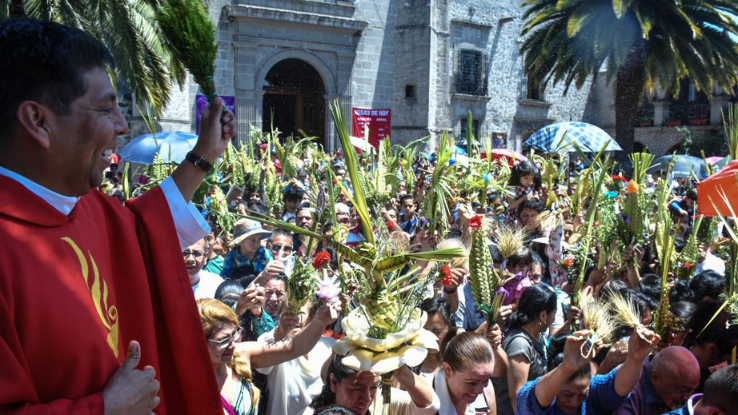What Is the Meaning of Lent?

For a lot of folks, Lent is that time during the spring when a friend isn’t eating chocolate for a few weeks. Traditionally, Lent is a fasting period practiced by Christians all over the globe. Its timing, like much of Easter, varies from year to year and it shares a lot with other religions’ fasting practices. However, the meaning of Lent goes beyond fasting, and it has changed a lot over time. Lent’s evolution may surprise you as much as it may surprise those of us who have practiced it for our entire lives.
The Why and When of Lent
Is “Lent” a variation on the word “lint?” Not so much. Is it the past tense of the word “lend?” Closer, but not quite. Lent comes from the Old English word “lencten,” which translates to “spring” in the English that is spoken today.

This makes sense as Lent is traditionally held during the 40 days before the first Sunday after the Paschal Full Moon. The Paschal Full Moon is the name given to the first full moon after the vernal equinox. This is less about honoring spring and more about coinciding with the Jewish holiday of Passover. It’s quite the stacked calendar but it’s easier to break down than it looks.
Biblical Origins, Jewish Influence & Easter’s Timeline
Lent’s 40-day period is meant to mirror the 40 days and 40 nights Jesus Christ spent in the desert fasting. Without food or water, Jesus warded off the devil, who tempted him with food and power during several legs of his wandering through the desert. The Holy Spirit led him to the wilderness after being baptized, presumably to face off with the devil. The fasting added to the temptations at the devil’s disposal.

Ash Wednesday is the day that kicks off Lent every year, but first it’s preceded by “Mardi Gras,” also known as “Fat Tuesday.” The idea behind that celebration is to cram in as much feasting as possible before the fasting begins. Ash Wednesday can differ from church to church. Some parishes hold a full-on Mass and bestow the ashes after, while others offer ashes all day long. The ashes symbolize death and the mourning of one’s sins.
Fast forward 40 days and you have Palm Sunday. That is the day Jesus returned from the desert. For many Christians, Palm Sunday Mass is a bit of a marathon. Most churches will be filled with stalks of palms and filled with incense. The service includes a reenactment of Jesus’s trial and the crowd even gets holy water sprinkled on them. This does not mean the end of Lent, however.
That week’s Tuesday is typically when Passover is held. It can be easy to forget that the Last Supper was a Passover seder, but this is why the holidays change dates and are so interrelated. For Christians, the Last Supper is commemorated later that week on Holy Thursday. Good Friday is the day that commemorates the execution of Christ, and, finally, Easter Sunday is the day that Jesus returned, just three days later. Only then can you have that chocolate you gave up.
The Meaning of Lent in 3 Pillars
Contrary to popular belief, Lent is about more than giving up a thing or two for six weeks. Fasting is one of the pillars of Lent, and the most direct way that one can mirror the story of Jesus in the desert. Lent’s other pillars are prayer and almsgiving.

The prayer pillar can be handled in a number of ways. It can mean going beyond the standard of Sunday mass and going to services on weekdays. It may mean getting involved with mass itself and volunteering to lead a reading. It could also mean praying the rosary in your own time. Devotion to the act of praying and praying with others is the emphasis here.
Almsgiving is a more underrated pillar of Lent, though it can be practiced at any time of year. “Giving alms” means supporting those less fortunate than yourself. This can range from donations to the church to supporting a gofundme to volunteering your time at a charitable place like a soup kitchen or Habitat for Humanity.
From Strict Beginnings to 20th Century Leniency: The Evolution of Lent
In earlier times, Lent was a bit more rigid in the fasting element. Many Christians used to forgo meat for the entirety of Lent to mimic Jesus’s fast. Nowadays most folks will only abstain from meat on Fridays. This is also why Lent is the only time you see fast food restaurants advertising their fish sandwiches.

According to Encyclopedia Britannica, the early centuries of Lent meant only one meal a day, usually at sundown, much like Ramadan. Apparently, during World War II, the church eased its fasting requirement from all 40 days to Ash Wednesday and Good Friday. This is probably because there was a very finite number of resources available, so people had to nourish themselves however they could, especially if they were serving in the war. It is interesting that the church never went back on that policy, however.
Today, Lent can mean a lot of different things to a lot of different people. Did you know that, technically, Lent includes cheat days? Remember how Pope Gregory originally said that Lent should start 46 days before Easter and should not include Sundays? Some folks interpret that as a time to enjoy a little bit of what you’ve given up for Lent. This can mean meat at supper or having a little bit of chocolate as a snack depending on what was given up.
One aspect of Lent that has not changed in a lot of churches is the lack of celebration during its services and in prayer. In some sects of Christianity, it’s customary to refrain from saying “The Glory” prayer and any others that have a celebratory tone. A lot of “Hallelujahs” are skipped over for somber psalms as well. This brings attention to the urgency of Lent, Jesus’s absence, and the reasons to fast, pray, and give alms.
How Lent Fits With Fasting and Other Religions
Intermittent fasting is more than a trend in the wellness community. The practice has deep-seated roots in religion and history. Lent is no exception to that. Almost every major religion has some form of fasting, so the meaning of Lent can be in part to create empathy with other religions. This way, shared experiences can be highlighted over differences.

For example, Judaism has six days a year where it is customary to begin fasting at sundown the night before a certain holiday like Yom Kippur. Other sects of Christianity have fasting holidays, too. Some Mormons fast every first Sunday of every month.
Observed by Muslim people, Ramadan is one of the most prominent fasting holidays. For one month, those who celebrate abstain from food while the sun is up. The time period changes by the year, so some years the number of hours a day one fasts is greater than in others. Fasting is one of the five pillars of Islam, so the practice is emphasized in the religion as a whole.
Eastern religions also make space for fasting. In Hinduism and Jainism there’s a “vrata,” or a vow to abstain from food for a period of time to promote good health and fortune. Bahai features a 19-day fast once a year. In Buddhism, depending on what path one is on, fasting can be a frequent part of life — or fasting can be off limits entirely because it skews the balance between hunger and fullness.
The Overall Meaning of Lent

As flowers bud and bloom, animals emerge from hibernation, and the ground is broken up for new life to grow there, it’s important to remember that spring is a time that is lush and full of birth and rebirth. The meaning of Lent can vary from person to person or church to church, but its annual celebration epitomizes spring as a whole and the fast serves as a great excuse to do a lot of good. Whether you celebrate Easter by going to church, hunting for eggs, or attending brunch, there is a lot to appreciate, fasting or not.





